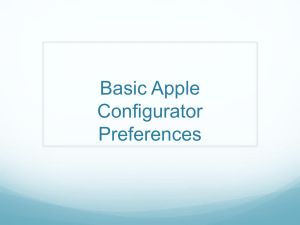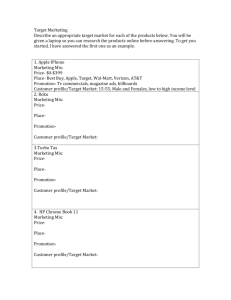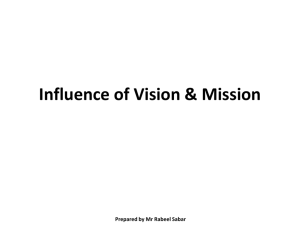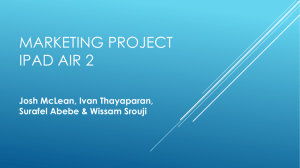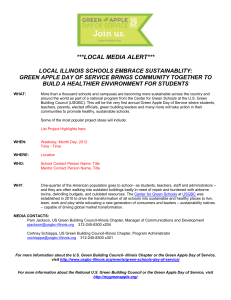Apple Paper
advertisement
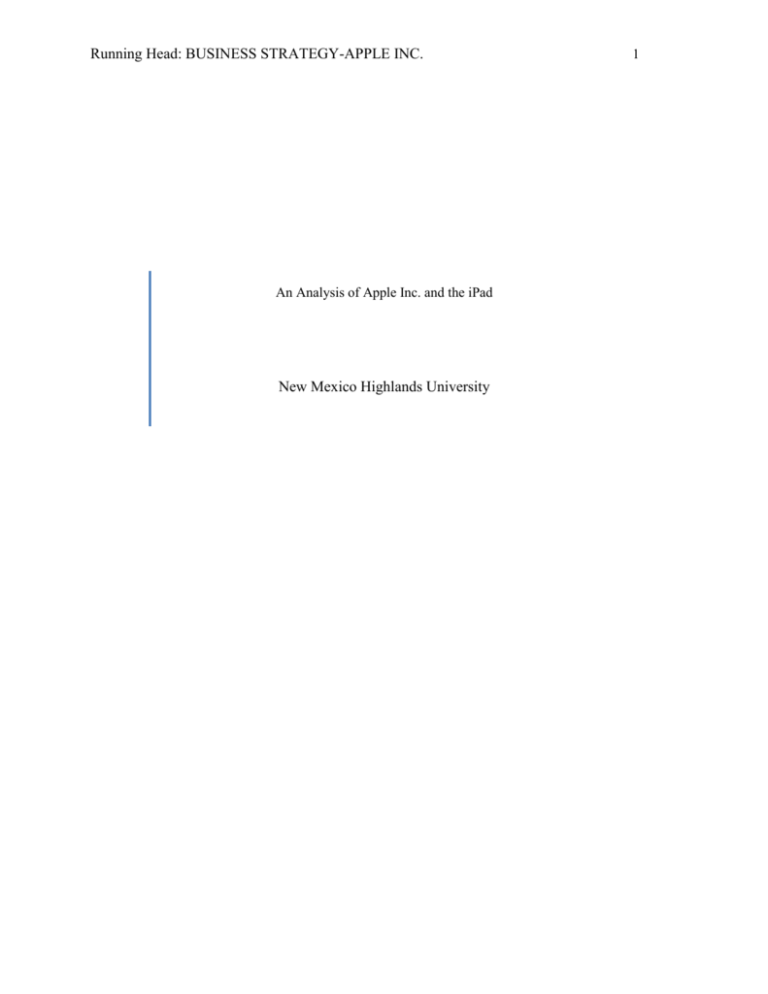
Running Head: BUSINESS STRATEGY-APPLE INC. An Analysis of Apple Inc. and the iPad New Mexico Highlands University 1 BUSINESS STRATEGY-APPLE INC. 2 Table of Contents Executive Summar ........................................................................................................................................ 4 1.0 Strategic Focus ........................................................................................................................................ 5 1.1 Mission Statement. .............................................................................................................................. 5 1.2 Company Goals. .................................................................................................................................. 5 2.0 The Business ........................................................................................................................................... 5 2.1 History................................................................................................................................................. 5 2.2 Life Cycle............................................................................................................................................ 6 2.3 Past Performance. ............................................................................................................................... 6 3.0 Market Analysis ...................................................................................................................................... 7 3.1 Macro-environment............................................................................................................................. 7 3.2 Industry Report. .................................................................................................................................. 7 5.1 Marketing Strategy.............................................................................................................................. 9 6.0 Research & Development ..................................................................................................................... 10 6.1 Current and Planned Research and Development. ............................................................................ 10 6.2 Intellectual Property Protection. ....................................................................................................... 10 7.0 Stakeholders .......................................................................................................................................... 11 8.0 Environmental & Social Impact ............................................................................................................ 11 8.1 Current Situation. .............................................................................................................................. 11 8.2 Environmental & Social Impact Strategies. ...................................................................................... 12 9.0 Regulatory Compliance ........................................................................................................................ 12 10. Corporate Governance .......................................................................................................................... 13 10.1 Corporate Structures. ...................................................................................................................... 13 10.2 Board of Directors........................................................................................................................... 13 10.3 Duties and Responsibilities of the Board. ....................................................................................... 14 11.0 Financials ............................................................................................................................................ 14 11.1 Financial Statements. ...................................................................................................................... 14 11.2 Financial Performance. ................................................................................................................... 15 12.0 Strategic Action Plan .......................................................................................................................... 17 12.1 SWOT Analysis. ............................................................................................................................. 17 BUSINESS STRATEGY-APPLE INC. 3 12.2 Objectives and Strategies. ............................................................................................................... 17 References ................................................................................................................................................... 19 Appendix A ................................................................................................................................................. 20 Appendix B ................................................................................................................................................. 24 BUSINESS STRATEGY-APPLE INC. 4 Executive Summary A successful business evaluates its current position and creates strategies to assist management in directing the company to achieve its goals. A common tool used in strategic planning is a SWOT (Strengths, Weaknesses, Opportunities, and Threats) analysis, which examines the company’s position in the market at the time of the analysis. Existing strategies are then modified based on this analysis and if necessary, new strategies are formulated. The purpose of this paper is to provide information regarding Apple’s current position in the tablet manufacturing industry. Recommendations for strategy alterations and implementations can then be made, based on the SWOT analysis, which will ensure that Apple continues to develop iPads that satisfy its customers’ needs. A successful business strategy will allow Apple to continue to be a leader in the tablet manufacturing industry. BUSINESS STRATEGY-APPLE INC. 5 An Analysis of Apple Inc. and the iPad® 1.0 Strategic Focus 1.1 Mission Statement. The founders of Apple, Steve Jobs and Steve Wozniak, did not develop a mission or vision statement. It was rumored that the unofficial mission statement was the quote, “[t]o make a contribution to the world by making tools for the mind that advance humankind,” (Blodget, 2013) made by Steve Jobs in the 1980’s. Press releases by Apple are concluded with the sentence “Apple is committed to bringing the best personal computing experience to students, educators, creative professionals and consumers around the world through its innovative hardware, software and Internet offerings” (Farfan) which is perhaps the company’s mission statement. 1.2 Company Goals. While there is no all-encompassing goal provided by Apple, numerous individual goals are mentioned by its executives and on its website. Jonathan Ive, senior VP of design, “has two main goals in mind when developing products.” (Fiegerman, 2012) Apple’s design goals are to keep the design simple and create products that appear inevitable. Another company goal is stated in the section of its website dedicated to its environmental impact. The goal “to power every facility at Apple with energy from renewable sources – solar, wind, hydro, and geothermal” (Apple Info) appears to be meeting with success according to statistics reported by the company. 2.0 The Business 2.1 History. Apple, Inc. is an American corporation founded April 1, 1976 and headquartered in Cupertino, California. Apple had been working with the idea of a tablet since 1979, when the accessory Apple Graphics Tablet™ was offered for the Apple II®. It was not until 1993 that Apple introduced its first tablet computer, the Newton MessagePad 100®. The BUSINESS STRATEGY-APPLE INC. 6 company discontinued its tablet production in 1998 with the MessagePad 2100® and did not reenter the mobile-computing market until 2007 with the iPhone®. The iPad was announced by Steve Jobs at an Apple press conference on January 27, 2010, at the Yerba Buena Center for the Arts in San Francisco. The following table lists all the release dates and countries for the iPad: Release Date Countries April 3, 2010 United States May 28, 2010 United Kingdom, Canada, France, Germany, Australia, and Japan July, 23, 2010 Mexico, Ireland, New Zealand, Hong Kong (only city in China) September 17, 2010 China Apple has since then improved its design and re-released its tablet computer over multiple generations. The iPad 2® was released in the United States one year after the iPad, on March 11, 2011. Yet another model, the iPad 3®, was released a year later on March 16, 2012. Eight months passed before Apple released its next model on November 2, 2012, the iPad 4® as well its first iPad mini®. The newest model is the iPad Air® which was just released November 1, 2013. The new iPad mini® (with Retina display) being released with the iPad Air was available November 12, 2013. “[T]he introduction of Apple’s iPad … marked the beginning of a new era.” (Son, 2013) 2.2 Life Cycle. “The Online Computer and Tablet Sales industry is in the growth stage of its life cycle, with rising participation and rapid technological advancements.” (Son, 2013) Projections have been made that indicate the value added to the economy by the tablet industry will grow faster than the United States gross domestic product. The industry’s growth has been driven by technological innovations and improvements. 2.3 Past Performance. Apple sold more than fifteen million first-generation iPads prior to the launch of the iPad 2, selling more than all other tablet PCs combined prior to the iPad’s BUSINESS STRATEGY-APPLE INC. 7 release and reached 75% of tablet PC sales by the end of 2010. Since the original iPad was introduced the company has reported that 170 million tablets have been sold. In the past three years Apple has experienced revenue increases from iPad sales of 52.0% (2010), 66.0% (2011) and 45.2% (2012). (Son, 2013) 3.0 Market Analysis 3.1 Macro-environment. The macro-environment consists of trends in gross domestic product (GDP), inflation, employment, spending, and monetary and fiscal policies. The current GDP of the United States is 15.68 trillion USD with a current growth rate of 2.8. After experiencing negative GDP growth rates between 2008 and 2010, the United States has consistently had positive growth rates. The average inflation rate for 2012 was 2.1 and to date the average inflation rate for 2013 is 1.51. Since October 2009 when the unemployment rate was 10.0% the United States has recovered only 2.7 points and currently has an unemployment rate of 7.3% as of August 2013. This is good news for the economy; however the unemployment rate still has not reached its pre-recession levels of 4.4% from May 2007. The economic climate of the United States has improved and changes to monetary and fiscal policies will influence the direction the economy takes. 3.2 Industry Report. The industry report available through Ibisworld contains a wealth of information regarding the tablet industry. The online computer and tablet industry is a global, high competition, high growth industry with few barriers to entering the market. With annual growth of 10.7% from 2008 to 2013 and projected annual growth of 7.8% from 2013 to 2018, this is an appealing industry to technology manufacturers. Competition is fierce in this industry, “with the top four companies accounting for about 57.5% of total market share.” (Son, 2013) According to Ibisworld Apple holds approximately 13.0% of that 57.5% market share. A major BUSINESS STRATEGY-APPLE INC. 8 competitor to the Apple iPad is the Amazon Kindle®; Amazon holds approximately 35.3% of the 57.5% market share. Apple continues to experience high growth due to “its innovative nature in producing … tablets.” (Son, 2013) Apple remains competitive as a result of its high profit margins resulting from manufacturing its own products. 4.0 Products Since the introduction of the iPad in 2010 Apple has produced numerous generations of its famous tablet computer. The older generations can still be purchased, new and used, through various retailers. However, Apple is currently producing four models available for sale at the 250 Apple Stores found in 44 states and online at Apple.com. These models are the iPad Air®, iPad 2®, iPad mini (Retina display)®, and iPad mini®. The first table provides the details of Apple’s current tablet prices. iPad Air Wi-Fi 16 GB $ 499 32 GB 599 64 GB 699 128 GB 799 iPad 2 iPad mini (Retina) iPad mini Wi-Fi Wi-Fi Wi-Fi 16 GB $ 399 16 GB $ 399 16 GB $ 299 32 GB 499 64 GB 599 128 GB 699 Wi-Fi + Cellular 16 GB $ 629 32 GB 729 64 GB 829 128 GB 929 Wi-Fi + 3G 16 GB $ 529 Wi-Fi + Cellular 16 GB $ 529 32 GB 629 64 GB 729 128 GB 829 Wi-Fi + Cellular 16 GB $ 429 1 The next table lists key specifications of the four models current manufactured by Apple. A more detailed listing of each tablet’s features is available at the Apple website. 1 Capacity and Price obtained from www.apple.com/ipad/compare BUSINESS STRATEGY-APPLE INC. Weight Display Chip Cameras Videos iPad Air 1 pound Retina display 9.7' LED A7 FaceTime HD iSight Camera 1080p HD iPad 2 1.33 pounds 9.7' LED A5 FaceTime Back Camera 720p HD 9 iPad mini (Retina) 0.73 pound Retina display 7.9" LED A7 FaceTime HD iSight Camera 1080p HD iPad mini 0.68 pound 7.9" LED A5 FaceTime HD iSight Camera 1080p HD 2 5.0 Marketing 5.1 Marketing Strategy. When the iPad was introduced to the market in 2010 it appeared that the tablet was so publicized it practically advertised itself. As it turns out, that assessment was an accurate description of Apple’s marketing strategy. Although Apple does spend a portion of its operating budget on advertisement, the company can spend less on advertising than its rivals and still be successful by using the media to advertise and relying on brand loyalty. This allows the company to invest those excess funds elsewhere. Apple’s marketing strategy in regards to brand loyalty is a set of ten strategies, based on the original three point marketing philosophy introduced by Mike Markkula. Christine Moorman labels and describes these strategies in her article, “Why Apple is a Great Marketer.” (Moorman, 2012) (1) Hire customer-obsessed, empathetic employees. (2) Iterative customer involvement. (3) Protect against scope creep and feature bloat. (4) Build compatible experiences. (5) Enable customer discovery and differentiation through Apple stores. (6) Build a moat. (7) Devise a business model that creates ongoing customer value. (8) Cannibalize when necessary. (9) Don’t try to be all things to all customers. 2 Chip A7: 64-bit architecture and motion coprocessor; Chip A5: Dual-core chip BUSINESS STRATEGY-APPLE INC. 10 (10) Create and ecosystem that makes offerings valuable. Another integral part of Apple’s marketing strategy is celebrity appeal. “One of Apple’s employees works closely with Hollywood on so-called product placement so its gadgets are used in movies and television shows.” (Stampler, 2012) The first iPad was launched when Steve Jobs, master of marketing mystique, was the CEO of Apple. It remains to be seen if the company can sustain this marketing strategy as competition builds in the tablet industry. 6.0 Research & Development 6.1 Current and Planned Research and Development. A consistent theme found in researching Apple, Inc. is the importance placed on secrecy. Although Apple provides an extensive list of non-exhaustive trademarks on its website, the company understandably does not reveal its current research. There are rumors regarding the development of an iPad 6, which would likely be on the market in 2014. What is known for certain is the company spent $4,475,000 in 2013 on research and development, according to the 10-K filed with the SEC. 6.2 Intellectual Property Protection. “Apple’s innovation is embodied in its Intellectual Property, including Patents, Trademarks, and Copyrights.” (Apple Info) The company is aggressive in protecting its intellectual property as is apparent with the suit it filed against Samsung for patent infringement. On November 21, 2013, a jury in the retrial of Apple Inc. v. Samsung Electronics Co., Ltd. Reached a verdict, ruling that Samsung owes Apple an additional $290,456,793. As a result of this ruling, Apple is due to receive over $900 million from Samsung. (Tibken, 2013) This is just the latest ruling in the ongoing global disputes over intellectual property, patents, and trademarks. As of October 2011, Apple and Samsung were litigating nineteen ongoing cases in ten countries. The number of lawsuits increased to over fifty BUSINESS STRATEGY-APPLE INC. 11 by July 2012. (Apple Inc. v. Samsung Electronics Co., Ltd., 2013) This is a small sampling of the ongoing patent war that is raging in courtrooms around the world. 7.0 Stakeholders The terms shareholder and stakeholder should not be confused. As a global company, Apple has numerous stakeholders who have an interest in the company to varying degrees. A few groups are usually the primary focus of a company: management, employees, investors, customers and suppliers. Apple’s corporate management consists of nine individuals, including the Chief Executive Officer (CEO). The company currently employs 80,300 individuals with 50,250 of those employed in the United States. Apple’s twenty-four United States based technical support call centers, the company prides itself on not outsourcing, employs 10,000 individuals. As of September 2013, 161.7 million iPads were sold, which represents only a fraction of Apple sales, still this figure indicates a large number of iPad customers. (EDGAR Online, 2013) 8.0 Environmental & Social Impact 8.1 Current Situation. Beginning in 2009, Apple began measuring and reporting its total carbon footprint. It is a comprehensive listing of the company’s environmental impact from its facilities, manufacturing, transportation, product use, and recycling. In 2012 the company estimated it was accountable for 30.9 million metric tons of greenhouse gas emissions. Manufacturing, including the extraction of raw materials and product assembly, accounted for 61% or 18.849 million metric tons. The use of Apple products was the second highest producer, generating 30% or 9.27 million metric tons. Transporting its products from assembly locations to distribution hubs represents 5% or 1.545 million metric tons of greenhouse gas emissions. The company’s facilities (corporate offices, distribution hubs, data centers, and retail stores) BUSINESS STRATEGY-APPLE INC. 12 accounted for only 2% or 618 thousand metric tons in 2012. The remaining 2% is caused by Apple’s reclaiming by recyclers of its old materials for use in new products. 8.2 Environmental & Social Impact Strategies. Apple has been able to reduce its greenhouse gas emissions from its facilities through the use of clean energy. All company data centers are powered through renewable energy. Through the use of onsite renewable energy sources, including solar arrays, Apple has set the goal of using 100% clean, renewable energy at all of its facilities. Apple set and achieved its goal of a worldwide recycling rate of 70% as a result of it establishing recycling programs in the majority of countries where Apple products are sold. Rather than these products filling up landfills, they are being responsibly recycled. Transportation emissions are reduced by using thinner, lighter and more material-efficient products and packaging. “Efficient packaging design reduces materials and waste, and it also helps reduce the emissions produced during transportation.” (Apple Info) Product use and manufacturing are the two largest contributors to Apple’s greenhouse gas emissions. Reducing product use emissions is achieved by reducing the average power consumed by Apple products. The company is able to do this effectively due to designing both the hardware and operating system. Apple reduces its manufacturing greenhouse gas emissions by using less material while eliminating environmentally harmful substances (lead, arsenic, brominated flame retardants [BFRs], mercury, and polyvinyl chloride [PVC]). 9.0 Regulatory Compliance The computer and tablet industry must comply with relevant federal and state laws and regulations. As a publically traded United States company, Apple is required to file 10-K reports with the Securities and Exchange Commission (SEC). A significant law in the United States is the Sarbanes-Oxley Act of 2002 (SOX), enacted to protect investors from fraudulent activities. BUSINESS STRATEGY-APPLE INC. 13 Other countries (Japan, Germany, France, and Italy) have enacted legislature similar to. Apple complies with all relevant trade agreements and embargoes. Free trade agreements exist with twenty countries. The Trans-Pacific Partnership (TPP) Agreement, an Asia-Pacific trade agreement, is being developed. (Free Trade Agreements) Apple observes the embargoes held by the United States against Cuba, North Korea, Sudan, and Syria. Apple was issued its Iranian General License D by the Office of Foreign Assets Control (OFAC) on May 30, 2013. 10. Corporate Governance 10.1 Corporate Structures. Tim Cook is the Chief Executive Officer (CEO) of Apple, Inc. and a member of the company’s Board of Directors. The Chief Financial Officer (CFO) is Peter Oppenheimer, who is one of eight senior vice presidents. How Apple is organized is a closely guarded secret even after Tim Cook became CEO. Previously, it was known that all decisions passed through Steve Job’s desk; however, if this practice continues or if changes have been implemented is unknown. The names and positions of Apple’s other senior vice presidents are listed on its website and are as follows: Jeff Williams, senior VP of operations; Eddy Cue, senior VP of internet software services; Dan Riccio, senior VP of hardware engineering; Graig Federighi, senior VP of software engineering; Philip Schiller, senior VP of worldwide marketing; Jonathan Ive, senior VP of design; and Bruce Sewell, senior VP and general counsel. The corporate structure of Apple has been created to be a “working structure for principled actions, effective decision-making and appropriate monitoring of both compliance and performance.” (Apple Info) 10.2 Board of Directors. Eight members comprise the Board of Directors for Apple, Inc., including the company CEO Tim Cook. Directors serve one-year terms with the only limitation on the number of terms a member can serve being age. An individual may not be re- BUSINESS STRATEGY-APPLE INC. 14 elected to the Board after age seventy-five. The chairman of the Board is Arthur D. Levinson, Ph. D. The remaining six Board members are: Albert Gore Jr., former Vice President of the United States; Robert A. Iger, President and CEO of The Walt Disney Company; Bill Campbell, chairman and former CEO of Intuit Corp.; Andrea Jung, senior advisor to the Avon Board of Directors; Millard Drexler, chairman and CEO of J. Crew; and Ronald D. Sugar, Ph. D., former chairman and CEO of Northrop Grumman. 10.3 Duties and Responsibilities of the Board. The Board supervises the Chief Executive Officer (CEO) and the other senior management to safeguard the interests of the shareholders. “To satisfy its duties, directors are expected to take a proactive, focused approach to their position, and set standards to ensure that the Corporation is committed to business success through the maintenance of high standards of responsibility and ethics.” (Apple Info) All Board members are expected to attend the annual shareholders meeting as well as all Board and committee meetings, which will meet a minimum of four times per year. 11.0 Financials 11.1 Financial Statements. The full financial statements for 2013 are included in the appendix A, following are selected financial data taken from Apple’s 2013 SEC 10-K. BUSINESS STRATEGY-APPLE INC. Net sales Net income Earnings per share: Basic Diluted Cash dividends declared per share Shares used in computing earnings per share: Basic Diluted Total cash, cash equivalents and marketable securities Total assets Long-term debt Long-term obligations (3) Total liabilities Total shareholders' equity 15 2013 170,910 37,037 2012 156,508 41,733 2011 108,249 25,922 40.03 39.75 11.40 44.64 44.15 2.65 28.05 27.68 - 925,331 931,662 934,818 945,355 924,258 936,645 146,761 207,000 16,960 20,208 83,451 123,549 121,251 176,064 16,664 57,854 118,210 81,570 116,371 10,100 39,756 76,615 (in millions, except number of shares, which are reflected in thousands, and per share data amounts) 3 Apple’s net sales for the iPad in 2013 were $31,980,000 which was 19% of its total net sales. 11.2 Financial Performance. Financial performance is a measure of a company’s financial health based on financial ratios calculated from the company statements. The following financial ratios are those commonly used by investors when assessing a company. The industry standards data was obtained from research on Google Finance (Apple Inc. (NASDAQ:APPL)) and BizStats (BizMiner, 2010). 3 Long-term obligations exclude non-current deferred revenue. BUSINESS STRATEGY-APPLE INC. Current Ratio Acid-test Ratio Gross Profit Margin Operating Profit Margin Return on Assets (ROA) Return on Average Equity (ROE) Debt-Equity Ratio Interest Coverage Ratio Operating Cash Flow/Sales Ratio Earnings per share (EPS) Price / Earnings Ratio (P/E Ratio) 16 Apple (2013) 1.68 1.23 37.62% 28.67% 19.34% 30.64% 67.54% 369.79 31.40% $ 40.03 $ 39.75 14.15 Industry 1.20 0.67 6.39% 13.55% 112.00% $ 10.07 24.33 A financial analyst would likely determine that Apple Inc. has a strong financial position based on this information. The company can easily cover its current liabilities (bills) even with just its most liquid assets, a notable difference from the industry average. The company maintains high profit margins, indicating management is able to manage costs and expenses in order to generate profits. Technology businesses tend to be non-capital-intensive and generally have relatively high ROAs, which Apple is successful in achieving. The higher the ROE, the more efficient management is in utilizing its equity base equaling higher investor returns. A large debt-equity ratio can be an indication something may be wrong with the company. Large, well-established companies like Apple often can have higher percentages without experiencing difficulties. Not all tablet manufacturers may be as well established, and with such a high industry average this is an area requiring further analysis of the competition. An operating cash flow/sales ratio of 31.40% means that approximately $0.31 of operating cash flow is generated by every sales dollar, indicating that Apple is able to convert sales into cash. Historically, the average P/E ratio for the broad market is 15.0, which Apple is significantly close to. The industry average is slightly higher indicating investors are expecting higher earnings growth in the future compared BUSINESS STRATEGY-APPLE INC. 17 to the general market. Apple’s stable P/E ratio is a sign the company will continue to grow at a stable rate, indicating its stock may be a secure investment for long-term investors. 12.0 Strategic Action Plan 12.1 SWOT Analysis. Apple’s strengths are its brand loyalty, innovative technology, low manufacturing costs from developing both its hardware and software, environmental policies, and strong financial position (high ROA, high ROE, low debt-equity). The company’s smaller market share compared to Amazon probably indicates a weakness. Its current marketing strategy, while previously a strength, may become a weakness as a result of industry competition. Technology compatibility issues, specifically with Adobe Flash Player®, are a source of annoyance for iPad users with the current solution being the use of an application that supports flash (Facebook, Puffin, iSwitter, iPhoton). Unfortunately, it is unlikely that Adobe will ever develop an iOS version. Apple has the opportunity to increase its market share in the growing tablet industry. The company should has the chance to build on its contracts with other businesses since its products are high quality and in high demand. Apple has been the leader of innovation and design in the industry and has the potential to maintain that role in the future. Market competition is a leading threat to Apple in an industry where technological advances are occurring regularly. The iPad can become obsolete if Apple does not keep up with changes in technology. 12.2 Objectives and Strategies. With competition increasing, Apple needs to ensure that the iPad still has the most to offer its users. The company should focus on developing new models that satisfy its customers’ needs. Apple cannot allow its competition to become the preferred hardware due to software compatibility concerns. Continued investments into research and development are necessary for the company to continue to be profitable in the future. In the BUSINESS STRATEGY-APPLE INC. 18 future, the marketing strategy may need to be adapted, possibly by increasing the company’s advertising budget. Apple can utilize the popularity of sites like YouTube® by developing advertisements to be aired online instead of the traditional television advertisements. Fundamental to Apple’s success is the ethical leadership of the company, determined by the policies and practices of its management. As seen historically, unethical practices to achieve short-term gains can lead to long-term downfalls. For the most part, the company does not need to alter much of its current operating strategies to continue to be successful in the next ten years. BUSINESS STRATEGY-APPLE INC. 19 References Apple Inc. (NASDAQ:APPL). (n.d.). Retrieved November 2013, from Google Finance: https://www.google.com/finance?q=NASDAQ%3AAAPL&ei=3-WeUujdDcGKiALdoAE Apple Inc. v. Samsung Electronics Co., Ltd. (2013, November 22). Retrieved November 2013, from Wikipedia: The Free Encyclopedia: http://en.wikipedia.org/wiki/Apple_Inc._v._Samsung_Electronics_Co.,_Ltd. Apple Info. (n.d.). Retrieved November 2013, from Apple Inc. [US]: https://www.apple.com/about/ BizMiner. (2010). Computers and Peripheral Equipment. Retrieved November 2013, from BizStats: http://www.bizstats.com/corporation-industry-financials/manufacturing-31/computer-andelectronic-product-manufacturing-334/computers-and-peripheral-equipment-334110/show Blodget, H. (2013, August 3). Apple's 'Mission Statement' is Making People Worry that the Company Has Gone to Hell. Retrieved November 2013, from Business Insider: http://www.businessinsider.com/apples-new-mission-statement-2013-8 EDGAR Online, I. (2013). Apple Inc. 10-K. Farfan, B. (n.d.). Apple Inc. Mission Statement is Not Very Innovative and Barely a Mission at All. Retrieved November 2013, from About.com: http://retailindustry.about.com/od/retailbestpractices/ig/Company-Mission-Statements/Apple-Inc-Mission-Statement.htm Fiegerman, S. (2012, May 23). Jony Ive Reveals The Secret of Apple's Design Strategy. Retrieved November 2013, from Business Insider: http://www.businessinsider.com/apples-ultimate-designgoal-is-to-make-products-seem-inevitable-2012-5 Free Trade Agreements. (n.d.). Retrieved Novemeber 2013, from Office of the United States Trade Representative: http://www.ustr.gov/trade-agreements/free-trade-agreements Moorman, C. (2012, July 10). Why Apple is a Great Marketer. Retrieved November 2013, from Forbes: http://www.forbes.com/sites/christinemoorman/2012/07/10/why-apple-is-a-great-marketer/ Son, A. (2013). IBISWorld Industry Report OD5078: Online Comptuter & Tablet Sales in the US. IBISWorld. Stampler, L. (2012, August 7). 12 Excellent Examples of How Apple Product Placements Rule Hollywood. Retrieved Novemeber 2013, from Business Insider: http://www.businessinsider.com/apple-product-placements-in-tv-and-movies-2012-8 Tibken, S. (2013, November 21). Jury Reaches Verdict in Apple v. Samsung Damages Retrial. Retrieved November 2013, from C-Net: http://news.cnet.com/8301-13579_3-57613382-37/jury-reachesverdict-in-apple-v-samsung-damages-retrial/ BUSINESS STRATEGY-APPLE INC. 20 Appendix A Apple Inc. 2013 Financial Statements Apple Inc. Income Statement For the Year Ended September 28, 2013 (in millions, except number of shares which are relected in thousands and per share amounts) Net sales Cost of sales Gross operating profit Operating expenses Research and development Selling, general and administrative Total operating expenses Operating profit Other income/(expense), net Earnings before income taxes (EBT) Provision for income taxes Net income 170,910 106,606 64,304 4,475 10,830 $ Earnings per share Basic Diluted 40.03 39.75 Shares used in computing earnings per share Basic Diluted Cash dividends declared per common share 15,305 48,999 1,156 50,155 13,118 37,037 925,331 931,662 $ 11.40 BUSINESS STRATEGY-APPLE INC. 21 Apple Inc. Balance Sheet September 28, 2013 (in millions) ASSETS Current assets Cash and cash equivalents Short-term marketable securities Accounts receivable, less allowances of $99 and $98 Inventories Deferred tax assets Vendor non-trade receivables Other current assets Total current assets Long-term marketable securities Property, plant and equipment, net Goodwill Acquired intangible assets, net Other assets Total assets LIABILITIES AND SHAREHOLDERS' EQUITY Current liabilities Accounts payable Accrued expenses Deferred revenue Total current liabilities Deferred revenue - non-current Long-term debt Other non-current liabilities Total liabilities Shareholders' equity Common stock, no par value; 1,800,000 shares authorized, 899,213 and 939,208 shares issued and outstanding, respectively Retained earnings Accumulated other comprehensive income/(loss) Total shareholders' equity Total liabilities and shareholders' equity 14,259 26,287 13,102 1,764 3,453 7,539 6,882 73,286 106,215 16,597 1,577 4,179 5,146 207,000 22,367 13,856 7,435 43,658 2,625 16,960 20,208 83,451 19,764 104,256 (471) 123,549 207,000 BUSINESS STRATEGY-APPLE INC. 22 Apple Inc. Statement of Stockholders' Equity For the Year Ended September 28, 2013 (in millions, except number of shares which are reflected in thousands) Balance on September 29, 2012 Common Stock Shares Amount 939,208 16,422 Net income Other comprehensive income/(loss) Dividends and dividend equivalent rights declared Repurchase of common stock (46,976) Share-based compensation Common stock issued under stock plans, net of shares withheld for employee taxes 6,981 Tax benefit from equity awards, including transfer pricing adjustments Balance on September 28, 2013 899,213 Accumulated Other Total Retained Comprehensive Shareholders' Earnings Income/(Loss) Equity 101,289 499 118,210 37,037 (970) (10,676) (22,950) (10,676) (22,950) 2,253 (444) (587) 2,253 (143) 1,232 19,764 37,037 (970) 1,232 104,256 (471) 123,549 BUSINESS STRATEGY-APPLE INC. Apple Inc. Statement of Cash Flows For the Year Ended September 28, 2013 (in millions) Cash and cash equivalents, beginning of year Cash flows from operating activities: Net income 37,037 Adjustments to reconcile net income to cash generated by operating activities: Depreciation and amortization 6,757 Share-based compensation expense 2,253 Deferred income tax expense 1,141 Changes in operating assets and liabilities: Accounts receivable, net (2,172) Inventories (973) Vendor non-trade receivables 223 Other current and non-current assets 1,080 Accounts payable 2,340 Deferred revenue 1,459 Other current and non-current liabilities 4,521 Cash generated by operating activities Cash flows from investing activities: Purchases of marketable securities (148,489) Proceeds from maturities of marketable securities 20,317 Proceeds from sales of marketable securities 104,130 Payments made in connection with business acquisitions, net (496) Payments for acquisition of property, plant and equipment (8,165) Payments for acquisition of intangible assets (911) Other (160) Cash used in investing activities Cash flows from financing activities: Proceeds from issuance of common stock 530 Excess tax benefits from equity awards 701 Taxes paid related to net share settlement of equity awards (1,082) Dividends and dividend equivalent rights paid (10,564) Repurchase of common stock (22,860) Proceeds from issuance of long-term debt, net 16,896 Cash used in financing activities Increase/(decrease) in cash and cash equivalents Cash and cash equivalents, end of year Supplemental cash flow disclosure: Cash paid for income taxes, net 23 10,746 53,666 (33,774) (16,379) 3,513 14,259 9,128 BUSINESS STRATEGY-APPLE INC. 24 Appendix B Apple Inc. financial ratios calculated from financial statements. Stock Price (as of Dec. 3, 2013) Liquidity Measures Ratios Current Ratio 566.32 Industry 73,286 43,658 = 1.68 53,648 43,658 = 1.23 64,304 170,910 = 37.62% 48,999 170,910 = 28.67% 37,037 191,532 = 19.34% 6.39% Return on Average Equity (ROE) 37,037 120,880 = 30.64% 13.55% Debt-Equity Ratio 83,451 123,549 = 67.54% 112.00% 50,291 136 = 369.79 53,666 170,910 = 31.40% Acid-test Ratio Profitability Indicator Ratios Profit Margin Analysis: Gross Profit Margin Operating Profit Margin Return on Assets (ROA) 1.20 0.67 Debt Ratios Interest Coverage Ratio Cash Flow Indicator Ratios Operating Cash Flow / Sales Investment Valuation Ratios Earnings per share (EPS) Price / Earnings Ratio (P/E Ratio) Basic Diluted Delta 566.32 40.03 $ $ $ = 40.03 39.75 0.28 14.15 10.07 24.33

